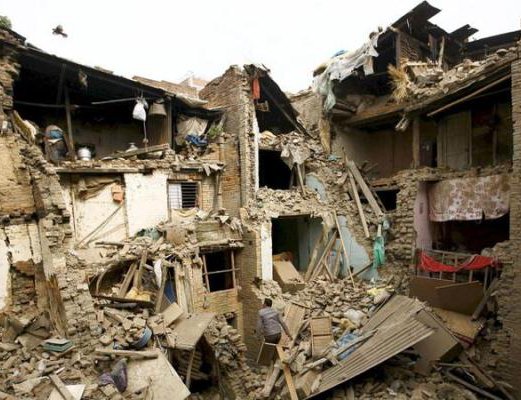
Although more than a year has already passed since the Gorkha Earthquake of April 2015, Kathmandu valley is still getting hit by earthquakes measuring close to 4 Richter scale almost every day.
According to a report released by the National Seismological Center, the Gorkha Earthquake was followed by 462 aftershocks with local magnitude 4 on the Richter scale until 16 June 2016. The number of over 3 Richter scale tremors was over 1000. The aftershocks are going around Kathmandu, Sindhupalchwok, Dolakha, Rasuwa, Gorkha, Dhading and Nuwakot.
As Nepal is situated in an active seismic zone, it has been facing many earthquakes every year. Along with the aftershocks, six earthquakes over 4 Richter scale have already rocked Nepal's Bajhang, Taplejung, Humla and Okhaldhunga.
As large numbers of earthquakes and aftershocks are shaking Nepal, a recent study report has pointed out that another major earthquake may be due in Nepal and that has badly shaken the mind of people.
Last year’s temblor left enough energy in the ground to fuel another major disaster, say scientists.
“The 7.8 earthquake that hit Nepal in April 2015 killed more than 8,000, moved the city 10 feet south, and crumbled innumerable buildings as if they were made of stale cake. Yet despite more than 100 aftershocks, there’s still enough pent-up energy below the ground to fuel another huge quake,” said a study published in Nature Geosciences.
In the aftermath of the disaster, scientists rushed to the Himalayas to assess the situation. What they found was the quake didn’t create a visible tear in the earth’s surface. That was odd. They thought the fault responsible had enough strain on it to cause nearly a dozen feet of ground-shift. That likely means there’s a great well of energy still pooled below the region, which future quakes can harvest with devastating consequences.
University of Colorado, Boulder, published a number of studies about what might be lurking in the seismic pipeline.
Historical earthquakes in the region—in 1803, 1833, 1905, and 1947—also failed to rupture the surface of the Himalayan frontal faults and they, too, experienced a lack of after slip or large subsequent earthquakes. That, according to the team’s research, means there is a significant strain throughout the region.
“There’s no evidence that it will spontaneously rupture in another damaging earthquake,” says [coauthor Roger] Bilham. “But the strain may fuel a future earthquake starting nearby. The entire Himalayan arc may host dozens of pockets of strain energy awaiting release in future great earthquakes.”
And this region remains vulnerable to earthquakes, not only because of its geography, but because of its architecture and development patterns. While this 2015 earthquake killed 8,000 people, left tens of thousands homeless, and destroyed parts of Kathmandu, the amount of strain built up in the faults, if released suddenly, could do much more damage in this part of the world.
Looking at the current state of post disaster work, what one can predict is that there will be much more damage than the last one. Although Disaster Management Division of Ministry of Home claimed that they are preparing to handle the disaster better, it is yet to take steps to improve the institutional mechanism.
As Disaster Management is an issue of multi-stake holder involvement, the government is yet to table a bill to replace the nearly four-decade old act for the purpose.
“The government is better prepared now and we are also holding consultations to present the new bill in the parliament,” Narayan Gopal Malegu, Home Secretary, told New Spotlight.
As the threat of a major earthquake is lurking, what Nepal needs to do is to prepare for another major earthquake for future.

Keshab Poudel
Poudel is the editor of New Spotlight Magazine.
- Heartbroken Family of Nepali Hostage Visits Site of Hamas Massacre, Urges Peace and Safe Return of Bipin Joshi
- Aug 14, 2025
- LIEUTENANT COLONEL JP CROSS: Centenary Birthday
- Aug 06, 2025
- Israeli Officials Say That 20 People Including Bipin Joshi Are Alive
- Aug 05, 2025
- RASUWAGADHI FLOOD: GLOF Devastation
- Jul 20, 2025
- ERC Nepal Is Focused On Expanding Distribution And Transmission To The Private Sector: ERC Chair Dr. Dhital
- Jul 06, 2025















